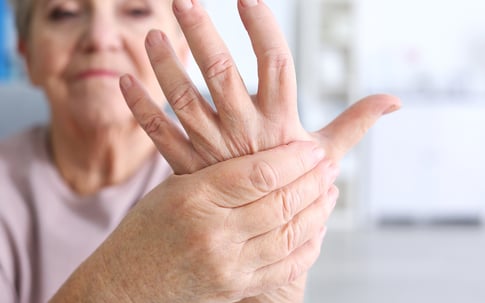Conditions Often Mistaken for Carpal Tunnel Syndrome: Unveiling Similar Ailments
 If you're experiencing hand pain, tingling, and numbness, you may assume you have carpal tunnel syndrome. While carpal tunnel syndrome is one of the most commonly diagnosed conditions causing pain and loss of function in the hand and wrist, it can be difficult to tell the difference between the different types of carpal tunnel and other ailments, such as a pinched nerve, wrist tendonitis, cubital tunnel syndrome, radial tunnel syndrome, neuropathy, and other joint conditions affecting the hand/wrist.
If you're experiencing hand pain, tingling, and numbness, you may assume you have carpal tunnel syndrome. While carpal tunnel syndrome is one of the most commonly diagnosed conditions causing pain and loss of function in the hand and wrist, it can be difficult to tell the difference between the different types of carpal tunnel and other ailments, such as a pinched nerve, wrist tendonitis, cubital tunnel syndrome, radial tunnel syndrome, neuropathy, and other joint conditions affecting the hand/wrist.
At The Center for Hand & Upper Extremity Surgery, our orthopedic surgeons in NJ specialize in carpal tunnel syndrome surgery, which can significantly relieve pain. However, getting the right diagnosis is key to proper treatment and relief.
Revealing Similar Hand and Wrist Conditions
Tendonitis
Wrist tendonitis refers to inflammation of the tendons around the wrist joint, often caused by repetitive strain from frequent hand motions. Activities requiring prolonged wrist use, like extensive texting, gaming, typing, or handwriting, can overwork the tendons and lead to microscopic tears and irritation. The resulting swelling and friction on the affected tendons produce pain, soreness, and sometimes limited mobility in the wrist.
To help prevent the onset of wrist tendonitis, it is important to avoid overuse of the joint by taking breaks during repetitive tasks, using ergonomic wrist positioning, and moderating durations of high-intensity wrist use. Early diagnosis, rest, ice, anti-inflammatory medication, and physical therapy can help treat cases of wrist tendonitis that do develop from repetitive stress before they become more serious. Corticosteroid injections or surgery may be considered in severe cases.
Arthritis
Arthritis is another common condition, affecting over 24% of adults, which can be misdiagnosed as carpal tunnel syndrome. Osteoarthritis and rheumatoid arthritis are the most common forms of arthritis affecting the hand and wrist area. Osteoarthritis involves wear-and-tear damage to the joint cartilage and bones. Rheumatoid arthritis is an autoimmune disorder that causes inflamed and painful joints.
Symptoms of arthritis include joint swelling, stiffness, pain, redness, and decreased range of motion. Treatment options for arthritis focus on pain relief and improved joint mobility. There is no cure for arthritis, but treatment and lifestyle changes can manage symptoms. This may include pain medication, steroids, supplements, physical therapy, or surgery. In addition, weight loss, regular exercise, joint protection, and eating an anti-inflammatory diet can help reduce arthritis symptoms and progression.
Neuropathy
Neuropathy is caused by damage to the nerves of the hand or wrist from underlying conditions like diabetes, vitamin deficiencies, autoimmune disorders, infections, tumors, trauma, or toxins. Unlike carpal tunnel syndrome, which primarily affects the palm side of the hand, thumb, index, and middle fingers (sparing the pinky and ring finger), neuropathy can cause numbness, tingling, burning, or pain throughout all parts of the hand and fingers.
Typical treatments for hand or wrist neuropathy include medications like gabapentin or anti-inflammatories to ease neuropathic symptoms, wrist splints or braces to provide stability and take pressure off nerves, physical therapy focused on improving range of motion and pain reduction, and steroid injections directly into affected nerves reduce inflammation and discomfort. Eliminating pressure on affected nerves, ergonomic adjustments, rest, and applying heat/cold can provide symptom relief. At the same time, treatment of underlying conditions like diabetes, thyroid disorders, autoimmune diseases, or other causes of neuropathy is key.
Pinched Nerves
A pinched nerve in the wrist is a fairly common injury that can cause numbness, tingling, weakness, and pain in the hand and finger. Some people assume any hand and wrist nerve issues are caused by carpal tunnel syndrome, but an orthopedic surgical specialist can identify if you have carpal tunnel vs pinched nerve. The carpal tunnel area is a frequent spot for pinched nerves due to its narrow shape, but other nerves that affect the hand and wrist, including the radial or ulnar nerves, can also be compressed or pinched in the radial tunnel or Guyon's canal.
Most pinched nerves can be treated with conservative methods such as rest, ice, splinting, and medication. However, in certain situations, steroid injections may be necessary to reduce inflammation, or surgery may be required to create more space around the nerve for long-term relief. It is important to seek medical advice to determine the best course of treatment.
Cubital Tunnel Syndrome: The Elbow Connection
Cubital tunnel syndrome involves compression of the ulnar nerve as it passes through the cubital tunnel on the inner elbow. The ulnar nerve runs from the neck down to the ring and pinky fingers. When the cubital tunnel becomes compressed, it can irritate the ulnar nerve. This leads to numbness, tingling, weakness, and pain in the ring and pinky fingers, which are the hallmark symptoms of cubital tunnel syndrome. Causes of cubital tunnel syndrome include leaning on the elbows, injuries, arthritis, bone spurs, cysts, repetitive bending, or congenital narrowing,
Treatment options include rest, ice, elbow splinting, anti-inflammatory medication, and modified activities to relieve compression on the ulnar nerve. In severe cases, surgery may be recommended to open more space around the ulnar nerve and relieve compression.
Radial Tunnel Syndrome
Radial tunnel syndrome involves compression of the radial nerve as it passes through the radial tunnel located on the thumb side of the arm near the elbow. Compression of this nerve can lead to pain from the elbow down to the thumb, especially when twisting the forearm. This nerve tunnel can become compressed due to repetitive elbow bending, leaning on the elbows, arthritis, injuries, bone spurs, or cysts, resulting in numbness, tingling, and pain in the ring and pinky fingers.
Treatments include rest, immobilization braces, anti-inflammatory medication, ice, and avoiding aggravating motions. With proper treatment, most cases of radial tunnel syndrome resolve well. In severe cases, surgery is required to open more space around the radial nerve.
Spotting the Difference in Symptoms
 Carpal tunnel syndrome shares similarities with several other nerve and joint conditions affecting the wrist and hand. Comparing the exact location of pain, the intensity of symptoms, aggravating movements, and timing can help distinguish carpal tunnel from other conditions like cubital tunnel syndrome, radial tunnel syndrome, tendinitis, and arthritis.
Carpal tunnel syndrome shares similarities with several other nerve and joint conditions affecting the wrist and hand. Comparing the exact location of pain, the intensity of symptoms, aggravating movements, and timing can help distinguish carpal tunnel from other conditions like cubital tunnel syndrome, radial tunnel syndrome, tendinitis, and arthritis.
For example, carpal tunnel causes numbness and tingling specifically in the thumb, index, and middle fingers, while similar nerves entrapped elsewhere affect different finger patterns. Carpal tunnel pain amplifies with repetitive grasping, unlike other nerve tunnel pain. And carpal tunnel syndrome symptoms are often worse at night, which is not true of other conditions, such as tendonitis, which generally improves with rest.
Carpal tunnel syndrome and a variety of other conditions affect the nerves and tendons in the wrist and hand region but have some distinct differences. Being specific about your symptoms can help guide your conversation with your physician, and an accurate diagnosis is key to determining if symptoms are caused by wrist tendonitis vs. carpal tunnel syndrome, arthritis, or other nerve conditions, which will then guide appropriate treatment.
Not Sure If You Have Carpal Tunnel Syndrome?
Schedule a Consultation for an Accurate Diagnosis and Personalized Treatment Plan
The Center for Hand & Upper Extremity Surgery has a team of orthopedic surgeons who focus on performing carpal tunnel syndrome surgery. Our staff will assist you in examining all possible treatment options in order to arrive at a conclusive diagnosis. In the event that non-surgical treatments are not effective in alleviating your symptoms, your doctor will guide you in deciding on the most suitable surgical procedure based on the severity of your symptoms.

.webp)

